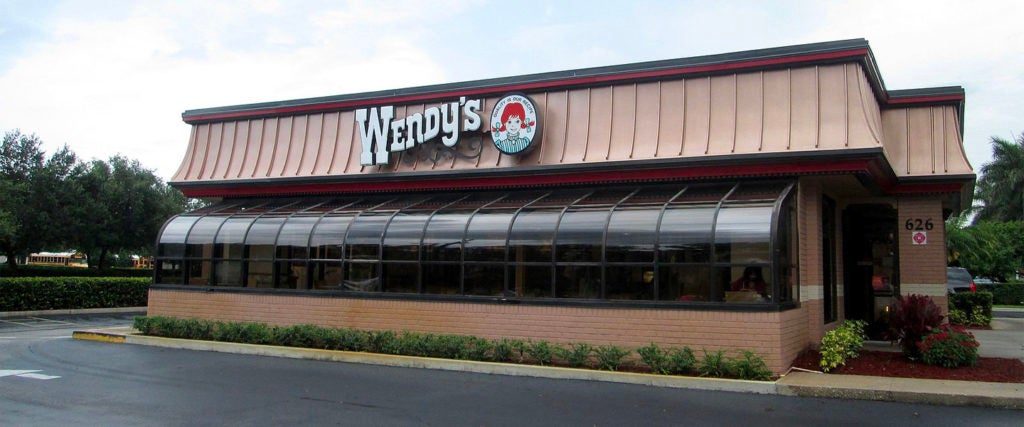For my money, nothing beats Wendy’s chicken nuggets. The perfectly crispy, ambiguously-shaped meat morsels have the ideal chicken-to-breading ratio, far outclassing the nuggets from any other fast-food joint. The best way to consume them though, isn’t in your car as you delicately balance the barbecue sauce, praying that it won’t spill onto your dashboard. Instead, it’s in the slightly-too-bright, slightly-too-warm (or too cold) sunroom of a Wendy’s restaurant.
Plenty of people have been pining for the Wendy’s sunroom lately. Case in point: In August, a wave of nostalgia poured over a certain generation of Wendy’s consumers, thanks to a viral tweet by @Tawdry_Lorde.
I forgot all about the Wendy’s sunroom!! The food tasted so much better when there was a sunroom and the packaging was yellow pic.twitter.com/WixDCSwlw8
— Harriet Thugman (@Tawdry_Lorde) August 29, 2021
While her tweet referred to the sunrooms as a relic of yesteryear — which, of course, they are — some locations still have them, including my own local Wendy’s. Unfortunately, though, the sun is about to set on them.
Starting back in 2012, Wendy’s began redesigning its restaurants with a more modern aesthetic that evokes comfort, a common trend for fast-food restaurants nationwide. “The tendency today is to be more living room-like, along the lines of Starbucks,” says Ray Caliendo, the founding principal of Art of Form Architects, which does a lot of work with fast-food restaurants around New York City. “Nowadays, they want to encourage people to stay for lengthy periods of time and possibly spend more money.” This mimics the philosophy of “fast casual” restaurants like Panera and Chipotle, both of which have cut into the fast-food market share considerably in recent years.
Funny enough, maximizing the space for comfort was precisely the thinking 40 years ago when sunrooms began to be installed on fast-food joints in the early 1980s. Back in 1985, the New York Times wrote about how fast-food establishments were changing, and they spoke to a guy named Denny Lynch who was then the vice president of communications for Wendy’s. “People who want to eat want to see other people eating,” Lynch explained. “If there’s no one there, the food must be bad. And when you’re eating, you want to look out. It increases the comfort level. You also have the opportunity to hang plants and create an upscale atmosphere.”
Fast-food sunrooms became so popular in the 1980s and 1990s that nearly all fast-food chains had locations with them. Everyone from Arby’s to Dairy Queen sported one, but the chain that became most synonymous with the airy chambers was Wendy’s, which installed sunrooms in most of their restaurants. Despite this, Wendy’s didn’t start the trend. Like most other fast-food innovations, that road leads back to McDonald’s.
If a wendy's doesn't have the sunroom then your not really a Wendy's pic.twitter.com/sEam9mmR91
— matthew (@mattymelts) May 15, 2020
In 1985, the Chicago Tribune wrote about “The Battle of the Atriums” in Skokie, Illinois, where a McDonald’s installed a sunroom directly across from a local restaurant that had one as well. The piece also explained that McDonald’s began installing sunrooms on corporate-owned locations in 1980 to create a comfortable environment, but as a practical way of adding more seating, too. “This reflected a general trend at the time which also saw atriums being put on people’s homes, particularly kitchen areas,” says Philip Langdon, author of Orange Roofs, Golden Arches: The Architecture of American Chain Restaurants.
Langdon goes on to tell me that the sunrooms provided a sense of spaciousness to fast-food establishments that were otherwise pretty bare-bone back in those days. He also says that the illusion of being outside, as well as an interest in solar energy at the time, may have helped fuel the trend, as natural lighting would be more appealing than the artificial alternative.
I miss the wendy’s sunroom https://t.co/iAW2dJ31lC
— sorry, im tweeting (@chaindawgg) April 14, 2021
Ironically, energy efficiency is a principal reason why fast-food sunrooms are presently on their way out. “They’re an energy problem,” Caliendo explains. “Most of those sunrooms were built before modern-day energy codes — they’re very inefficient. They increase the heat load tremendously during the summer, and in the winter, they’re pretty cold.”
Caliendo’s words definitely ring true for me. I have fond memories of the sun room at my local Wendy’s, but I also recall not ever wanting to sit in there during the winter.
The simplest, most basic reason for the removal of fast-food sunrooms, however, is that they’re just dated. Architecture writer Nate Berg explains that, after a while, just about any design becomes “wallpaper.” This is why fast-food joints are in need of frequent refreshers, with new lighting and new paint jobs every three-to-five years and a complete overhaul in design every decade or so. Unfortunately, because most sunrooms were installed on fast-food restaurants 30 or 40 years ago, this means that they likely wore out their welcome — at least, from an architectural perspective — more than two decades ago.
How I wish to be in the Wendy's sunroom instead of driving on my way to work right now pic.twitter.com/neDTDWpoyt
— Padlock (@Padlock_music) October 31, 2020
So, if you happen to be in a place where a fast-food sunroom still exists, I regret to inform you that you shouldn’t expect it to be there for much longer. As for me, I’m heading to my local Wendy’s and chilling in the sunroom with a six-piece order of nuggets. It may be a little chilly and the sun might blind me, but I wouldn’t want my Wendy’s any other way.

